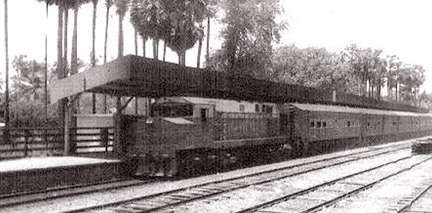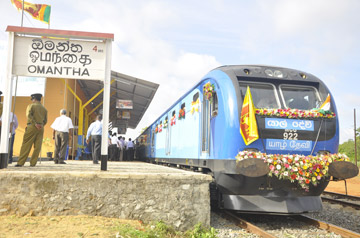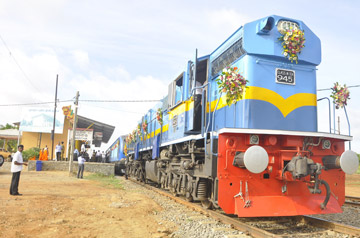Northern Railway service, some historical aspects
by Stanley E. Abeynayake
President Mahinda Rajapaksa in keeping with his wisdom and sagacity,
fully aware of the aspirations and sensing the ethos of the Jaffna Tamil
community re-established the train service from Colombo to Jaffna, vice
versa on October 19.
|

The Yal Devi hauled by a Canadian engine, at the Kondavil
station in 1985 |
That historical event took place after 24 years when the Northern
railway line together with stations, bridges, signal systems were
totally damaged and sabotaged by the terrorist LTTE cadres - posing as
the sole representatives, freedom fighters of the Sri Lankan Tamil
community. The longest railway line in our country was the most-popular,
safe, cheap mode of transport for the Northerners who found employment
down South in Sinhalese- speaking areas. They were gainfully employed in
the public service, private sector and were also engaged in professions
and varied business enterprises. So much so, several Jaffna Tamils were
employed in the Railway Department. It is to their credit that the first
Sri Lankan General Manager of Railways (C.G.R.) appointed in 1947, M.
Kangasabai. He joined the C.G.R. (Ceylon Government Railway) as a junior
clerk at the age of 17 and by dint of hard work honesty and integrity
rose up to be the head of that department.
Economically, for, the Northern Railway from Colombo to
Kankesanthurai was the common mode of transport of agricultural produce,
such as tobacco, plantains onions, chillies, fish and cement - a
manufactured product from the Kankesanthurai Cement Factory.
 |
| The day the
Yal Devi reached Omantha |
 |
| The Yal Devi
service was re-launched by President Mahinda Rajapaksa this year |
It is also pertinent to make mention of the colonisation of Yalpanam,
Jaffna-Patnam.
Yalpanam was established as a kingdom in the Jaffna peninsula and was
ruled by Tamil kings. It was conquered by the Portuguese and
Jaffnapatnam later came under the Dutch and later the British.
The peninsula was tremendously developed educationally by the
American Christian missionaries. They established a good number pf
English medium high schools or colleges and vernacular Tamil schools.
Their centre of English learning was Batticotta or Vaddukoddai.
The American missioneries established their leading college or
collegiate school Jaffna College at Vadukoddai. It is to their credit
that they set up the first western medical school at Manipay.
The Catholic missioneries too, arrived in Jaffna and established the
leading Catholic College, St.Patrick's in the Jaffna town. The Methodist
missionaries opened up Jaffna Central College in the Town.
The Church of England (now the Church of Sri Lanka) also entered the
educational field. At Chundikuli they established St.John's College and
Vembadi Girls' High school. The impetus for Hindu schools and revival of
Hindu culture was set in motion by Arumuga Sri Navalar. Jaffna Hindu
Collegiate became the leading English medium college school in the
peninsula. Later English medium find a colleges were begun in Manipay,
Kokuvil, Chavakachcheri etc.
English education came into existence paving the way for Jaffna youth
to obtain white collar jobs particularly in Colombo and other towns in
the Sinhala speaking areas - down South.The Jaffna Tamils came to be
known also the Scotsmen of the Northern Sri Lanka.
In the meantime, the British administration commenced to build
railway lines, first to Kandy from Colombo. With the beginning of coffee
and later tea production, railway train facilities rapidly expanded to
plantation areas in the hill country and the Kelani Valley, mainly to
transport cash crops to Colombo for shipment abroad.
The rapid progress regarding the advancement in the Jaffna peninsula
made it imperative to espouse the cause for the construction of a
railway line to the Northern Province. The clamour for same was made in
1887 by the educated Jaffna Tamils and business-minded people.
There is ample evidence in support of same at the National Archives
and the Railway Department record room. In response to this request the
Colonial Secretary approved that railway project in 1898. The sanction
was given publicity by the Governor of that time, West Ridgeway.
The Railway Department construction section undertook the railway
extension to the North, with the permission of the Colonial Secretary in
1899. The massive work the longest railway track from Colombo to
Kankesanthurai via Jaffna, the provincial capital was begun under the
supervision of the Chief Resident Engineer, an Englishman. The work was
to be completed in stages, the first stage of the rail road of 205 miles
was completed from Kurunegala to Anuradhapura 1.11.1904.
The second phase, from Anuradhapura to Chavakachcheri was completed
1.8.1905. The laying of the track from Kankesanthurai to Chavakachcheri
was over on 15.9.1905.
The final stage came to an end on 15.9.1902 with completion of the
construction from Chavakachcheri to Palali.
It may be of historical importance to mention about the mode of
transport of people and commercial products to and from Jaffna to
Southern parts before the advent of the railway to the Northern
Province.
The common vehicle of transport was the bullock cart. There were a
large number of carts in the Jaffna peninsula that were make use of to
convey cash crops such as tobacco, chillies, onions and palmyrah
products to Anuradhapura for distribution and marketing in the Sinhala-speaking
areas in the wet-zone, down south.
From Kurunegala goods such as coconut, rice, grains, yams etc were
taken by bullock carts to Anuradhapura. So, that town emerged as the hub
of commercial activities in the North. Coming of carts to Anuradhapura
became a grave problem in that city according to a report by the
Government Agent (G.A.), North Central Province. The convergence of
bullock carts that were parked in the town attained such proportions as
to be a public nuisance. That resulted in such an annoyance to the
general public that the Anuradhapura G.A. was compelled to impose a fine
of Rs. 50 to errant carters, specially for reckless riding of bullock
carts.
However, travelling from Jaffna by that mode of conveyance also
became perilous mainly during the North - East monsoon rainy season.
Moreover, the hazardous cart road from the Jaffna peninsula had to be
traversed through wild elephants and poisonous snakes infested thick
forests and jungles.Under these circumstances a few Jaffna entrepreneurs
adopted operating a sailing vessel service from Jaffna to Colombo.
Transport by a sea functioned occasionally. People travelling from Kandy
to Jaffna too, used bullock carts as a means of transport.
Bullock carts were used for transport services from Puttalam to
Anuradhapura and Trincomalee. The train service to the Northern Province
facilitated civil administration functions in that province. The railway
link Northwards resulted in demolition of isolation of the worth with
rest of our country.
1905 - the first train from Colombo arrived in Jaffna.
1956 - the express train began operations. 1985, the mail train to
KKS, was blown up by TEL6 cadres it Murukandy. 34 passengers in that
attack.
1985 - The mail train to KKS was blown up by TELO cadres at Murukandy.
34 passengers died.
1986 - the second attack near Vavuniya that destroyed the entire
track.
1990 - the Indian Peace Keeping Forces (IPKF) restored the line and
train service was restarted.
2009 - The track was rebuilt from Vavuniya to Mankulam. That took
place when the civil war was put to an end by President Mahinda
Rajapaksa in 2009. In the same year in June, the Thandikulam railway
station was set up.
2011 - Omanthai railway station was re-opened.
2013 - The railway from Omanthai to Kilinochchi commenced.
2014 - The line between Kilinochchi to Palai was established in
March.
It is to the great credit and unwavering devotion, the Colombo to
Jaffna service was re-established at a grand ceremony and a warm welcome
was accorded to the Head of State.
Bravo, President Mahinda Rajapaksa! |

